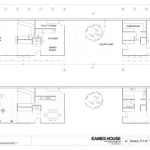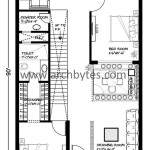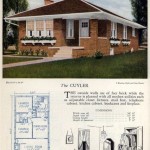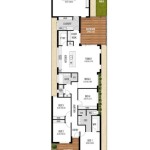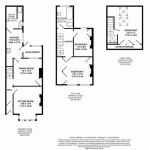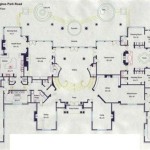2-Story Small Home Plans: Maximizing Space and Functionality
The demand for 2-story small home plans has steadily increased in recent years. This trend is driven by a variety of factors, including rising land costs, a growing emphasis on sustainable living, and the desire for efficient and well-designed spaces. These plans offer a viable solution for individuals and families seeking to build a comfortable and functional home without sacrificing affordability or style. Successfully executing a 2-story small home plan requires careful consideration of space utilization, layout design, and construction efficiency.
Two-story small home plans are defined by their relatively compact footprint and vertical design. The key advantage lies in the ability to maximize living space on a smaller plot of land compared to single-story alternatives. This is particularly beneficial in urban or suburban areas where land availability is limited and property values are high. The vertical expansion allows for the separation of living and sleeping areas, creating a more distinct division between public and private spaces within the home.
The design considerations for a 2-story small home plan are significantly different from those applicable to larger, more sprawling residences. Every square foot counts, and careful planning is crucial to avoid a cramped or cluttered feel. This often necessitates innovative storage solutions, multi-functional spaces, and a focus on natural light to create an open and airy atmosphere. Successful designs prioritize functionality and efficiency without compromising on aesthetics or comfort.
Key Point 1: Optimizing Layout and Space Utilization
One of the most critical aspects of designing 2-story small home plans is the efficient utilization of space. This requires a strategic approach to layout design, furniture selection, and storage solutions. Open-concept floor plans are frequently employed to create a sense of spaciousness and improve traffic flow between living areas, dining areas, and kitchens. Minimalism is often embraced to reduce clutter and maximize the feeling of openness within the home.
The placement of stairs is a crucial consideration, as they consume valuable floor space. Designing the staircase efficiently, such as incorporating storage beneath or using a spiral staircase, can help minimize its impact on the overall living area. The location of the staircase should also be strategically chosen to minimize disruption to the flow of traffic and maximize usability of adjacent spaces.
Vertical space is often underutilized. In 2-story small home plans, it is important to consider how to use vertical space effectively. This can include tall shelving units, floor-to-ceiling cabinets, and lofted areas for storage or living. Utilizing wall space for storage and decorative elements can also help to free up floor space and create a more organized and uncluttered environment.
Multi-functional spaces are another key element of efficient space utilization. A guest bedroom, for example, can be designed to double as a home office or hobby room. A dining area can be integrated into the kitchen design with a breakfast bar or island, providing additional counter space and seating options. Flexibility and adaptability are essential in small home design.
Furniture selection plays a significant role in optimizing space. Choosing furniture that is appropriately sized for the space and that serves multiple purposes can help to maximize functionality. For example, sofa beds, ottomans with storage, and nesting tables can provide additional seating, storage, and surface area without taking up excessive space.
Key Point 2: Incorporating Natural Light and Ventilation
Natural light and ventilation are crucial for creating a comfortable and healthy living environment in 2-story small home plans. Maximizing natural light can make a small space feel larger and more inviting, while adequate ventilation helps to improve air quality and prevent moisture buildup. Strategic window placement, skylights, and light wells can all contribute to enhancing natural light and ventilation within the home.
Window placement should be carefully considered to optimize sunlight exposure throughout the day. Southern exposure typically provides the most sunlight, while northern exposure offers a more consistent and diffused light. East-facing windows are ideal for morning sunlight, while west-facing windows can provide afternoon warmth and light. The size and type of windows should also be chosen to maximize light transmission and ventilation.
Skylights are an excellent way to bring natural light into interior spaces that may not have access to windows. They can be particularly effective in bathrooms, hallways, and kitchens. Skylights can also help to improve ventilation by allowing warm air to rise and escape from the top of the house.
Light wells are another option for bringing natural light into interior spaces. These are vertical shafts that extend from the roof to the interior of the house, allowing sunlight to penetrate deep into the building. Light wells can be particularly useful in basements or other below-grade spaces.
The orientation of the house on the lot can also impact natural light and ventilation. Orienting the house to maximize southern exposure can help to capture the sun's warmth in the winter, while providing shade in the summer. Proper ventilation can be achieved by positioning windows and doors to allow for cross-breezes.
In addition to natural light and ventilation, the use of light-colored paint and finishes can also help to brighten up a small space. Light colors reflect light, making the space feel larger and more open. Mirrors can also be used to amplify natural light and create the illusion of more space.
Key Point 3: Addressing Staircase Design and Safety
The staircase is a central element in any 2-story home, and its design and construction must be carefully considered to ensure safety, functionality, and aesthetic appeal. In small home plans, the staircase often presents a design challenge due to its spatial requirements. Efficient staircase design prioritizes minimizing its footprint while maintaining comfortable and safe dimensions.
Building codes typically dictate the maximum riser height and minimum tread depth for staircases. Adhering to these regulations is essential for ensuring the safety and accessibility of the stairs. The staircase should also be designed to be sturdy and stable, with adequate handrails and balusters to prevent falls.
Different types of staircases can be used in 2-story small home plans, each with its own advantages and disadvantages. Straight staircases are the simplest and most common type, but they can take up a significant amount of space. L-shaped staircases and U-shaped staircases can be more space-efficient, as they turn at a right angle or a 180-degree angle. Spiral staircases are the most compact type, but they can be challenging to navigate for some individuals.
The materials used for the staircase can also impact its appearance and functionality. Wood is a popular choice for staircases, as it is durable, aesthetically pleasing, and relatively affordable. Metal staircases can offer a more modern and minimalist look. Glass staircases can create a sense of openness and transparency. The choice of materials should be carefully considered to complement the overall design of the home.
Safety is a paramount concern when designing a staircase. Handrails should be securely attached to the wall or balusters and should be easy to grip. Balusters should be spaced closely enough to prevent children or pets from falling through. Adequate lighting should be provided on the staircase to improve visibility, particularly at night.
In addition to safety, the staircase should also be designed to be comfortable to use. The riser height and tread depth should be consistent throughout the staircase. The staircase should also be wide enough to allow people to pass each other comfortably. Attention to detail is crucial in ensuring that the staircase is both functional and aesthetically pleasing.
Integrating storage into the staircase design is a common practice in small home plans. The space beneath the staircase can be used for storage cabinets, drawers, or even a small powder room. Innovative storage solutions can transform the staircase from a purely functional element into a valuable storage asset.
Overall, 2-story small home plans present a unique set of design challenges and opportunities. By carefully considering space utilization, natural light, and staircase design, it is possible to create a comfortable, functional, and aesthetically pleasing home that maximizes value and minimizes environmental impact. Attention to detail and a strategic approach to planning are essential for successful execution.

Small Affordable 2 Story Home Plan North Ina Tennessee House Plans Narrow Floor

Custom 2 Story Houses New Two Home Plans Housing Development D House Layout Sims Layouts

10 Small House Plans With Open Floor Blog Homeplans Com

Plan 027h 0213 The House

Small 2 Story House Plans And Smart Tiny Two Level Floor

2 Story House Plans For Narrow Lots Blog Builderhouseplans Com

Small Home Design 6x9 5m With 2 Bedrooms Ideas Micro House Plans Layout Front

Small 2 Story House Plans And Smart Tiny Two Level Floor

House Plan 67219 Quality Plans From Ahmann Design

2 Y House Layout Plan Small Blueprints Plans One Level

